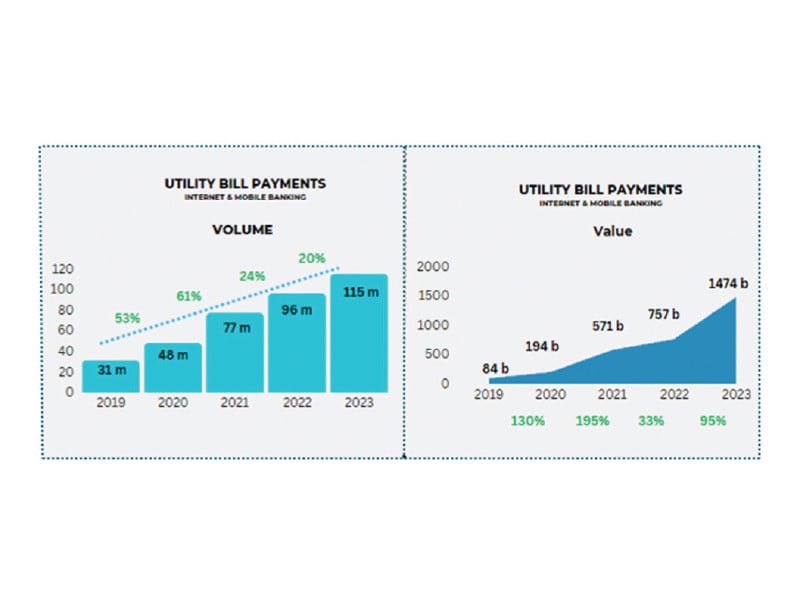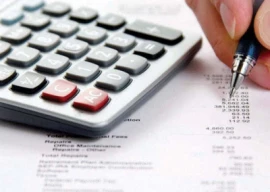
As per Nepra State of Industry Report, in FY23, 38.2 million electricity customers across Pakistan consumed 112 billion units through the year with a total value of Rs3.7 trillion. These numbers not only demonstrate the scale of the sector, but also a hidden opportunity.
Traditionally, Pakistan’s economy has run on a river of rupees with a heavy reliance on cash-based payments. But the tide is turning. Covid-19 became an unexpected catalyst, pushing businesses, and banks to expand their digital services and payment methods.
Data from the State Bank shows that the volume of utility bill payments through internet and mobile banking channels has grown 271% over the last five years. The value of these transactions has grown a whopping 1600%. This demonstrates that customers, initially wary, have started to embrace the convenience and security of online transactions.
The financial sector was able to accelerate its progress on the back of clear regulatory policies and a push to support digital transformation. They responded by offering a multitude of electronic payment channels and technologies, such as Raast, QR codes, and real-time online payments to amplify adoption of digital payment technologies.
For power companies, building a technologically advanced energy ecosystem requires looking beyond core operations. This is why future investment plans need to balance a focus on the grid with clear digitisation roadmaps.
This is what we have endeavoured to do at KE. Our investment plans envisage the pioneering addition of the first 500 kV grid in KE’s transmission sector, and digitisation for customer experience is also an essential ingredient of our future vision.
In 2020, only 150,000 customers connected with us through digital platforms; as of Q3FY24, this number stands at 1.8 million, or almost 50% of our total customer base. These numbers are no coincidence but the result of targeted initiatives and a clear digitisation strategy, post-privatisation.
In the last few years, KE has proactively partnered with over 40 banks and financial institutions and integrated secure, fast, and reliable payment gateways into our KE Live App and our website. Today, KE consumers can pay their bills using the utility’s KE Live app, website, mobile-based QR codes, and even e-wallets such as EasyPaisa or JazzCash.
The decision is deeply rooted in an ethos of customer convenience, and an understanding of their challenges.
Even today, there are areas of Karachi where customers have to travel significant distance to a bank, incurring a cost of time and money to pay their bills. Bringing a payment solution to their fingertips is the next logical step, as we already provide a plethora of other services – from availing income tax certificates to lodging complaints and applying for a change of name – through our platforms.
The power sector operates in a regulated environment. Prices of electricity charged to customers are immutable by utilities. However, we recognised the impact of inflationary pressures, and developed innovative solutions in the form of cashbacks to customers on their bills.
This wasn’t because of any special permissions or exemptions, but simply creative thinking, which is an extension of our agility as a privatised entity.
Our initiatives are also yielding tangible results. Today, seven out of every 10 customers are paying their bills without visiting a brick-and-mortar bank. Before Covid, this number was half. The growth is not only a sign of increasing digital literacy and tech-savvy, but also of a trust in the KE brand.
Sceptics may still question why a power utility, or any utility for that matter, should be concerned with digital inclusion or driving digital payments. This is only part of the problem we solve when we approach customer experience holistically.
If we look at the State Bank’s nationwide data for bill payments and mobile top-ups, bank branches still account for a large value of the transactions. These payments are a proxy indicator for cash in circulation.
If utilities can join the effort to enable a digital transformation, it can collectively reduce billions of physical rupees from the economy, while streamlining the cashflows. Each rupee printed – regardless of purpose – carries an inflationary cost which ultimately impacts the economy.
The International Monetary Fund has raised repeated concerns over Pakistan’s high CinC ratio and the urgency of improving the monitoring of economic activity in the country, neither of which can be achieved without adoption of digital payments.
So when we take stock of our digital journey, it has been enriching and educational. We have learned, reflected, adapted, and grown from strength to strength, letting our customers be our guide through these new frontiers. In doing so, we are leveraging our expertise and applying it to create sustainable solutions which can address larger problems.
Moving the needle begins with adapting inventive strategies, and proudly paving the way forward. Sometimes the solution is as simple as increased adoption of digital payments, starting perhaps, with your utility bills.
The writer is a communications professional with a focus on the energy sector in Pakistan. He tweets at @imranrana21

1725443747-0/Untitled-design-(5)1725443747-0-405x300.webp)


1724238420-0/Untitled-design-(3)1724238420-0-165x106.webp)













COMMENTS
Comments are moderated and generally will be posted if they are on-topic and not abusive.
For more information, please see our Comments FAQ